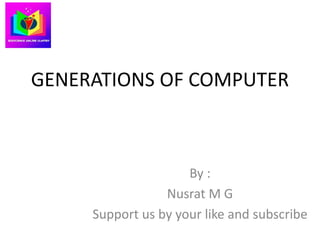
Generation of computer
- 1. GENERATIONS OF COMPUTER By : Nusrat M G Support us by your like and subscribe
- 2. Introduction • Computers are such an integral part of our everyday life now most people take them and what they have added to life totally for granted. • Even more so the generation who have grown from infancy within the global desktop and laptop revolution since the 1980s. • The history of the computer goes back several decades however and there are five definable generations of computers. • Each generation is defined by a significant technological development that changes fundamentally how computers operate – leading to more compact, less expensive, but more powerful, efficient and robust machines.
- 3. First Generation – Vacuum Tubes 1940 – 1956 • These early computers used vacuum tubes as circuitry and magnetic drums for memory. • As a result they were enormous, literally taking up entire rooms and costing a fortune to run. • These were inefficient materials which generated a lot of heat, sucked huge electricity and subsequently generated a lot of heat which caused ongoing breakdowns. • These first generation computers relied on ‘machine language’ (which is the most basic programming language that can be understood by computers). • These computers were limited to solving one problem at a time. Input was based on punched cards and paper tape. • Output came out on print-outs. The two notable machines of this era were the UNIVAC and ENIAC machines – the UNIVAC is the first every commercial computer which was purchased in 1951 by a business – the US Census Bureau.
- 4. Second Generation – Transistors 1956 – 1963 • The replacement of vacuum tubes by transistors saw the advent of the second generation of computing. • Although first invented in 1947, transistors weren’t used significantly in computers until the end of the 1950s. • They were a big improvement over the vacuum tube, despite still subjecting computers to damaging levels of heat. • However they were hugely superior to the vacuum tubes, making computers smaller, faster, cheaper and less heavy on electricity use. • They still relied on punched card for input/printouts. • The language evolved from cryptic binary language to symbolic (‘assembly’) languages. • This meant programmers could create instructions in words. • About the same time high level programming languages were being developed (early versions of COBOL and FORTRAN). • Transistor-driven machines were the first computers to store instructions into their memories – moving from magnetic drum to magnetic core ‘technology’. • The early versions of these machines were developed for the atomic energy industry.
- 5. Third Generation – Integrated Circuits 1964 – 1971 • By this phase, transistors were now being miniaturized and put on silicon chips (called semiconductors). • This led to a massive increase in speed and efficiency of these machines. • These were the first computers where users interacted using keyboards and monitors which interfaced with an operating system, a significant leap up from the punch cards and printouts. • This enabled these machines to run several applications at once using a central program which functioned to monitor memory. • As a result of these advances which again made machines cheaper and smaller, a new mass market of users emerged during the ‘60s.
- 6. Fourth Generation – Microprocessors 1972 – 2010 • After 1971 the fourth generation computers were built. • The fourth generation computers were the extension of third generation technology. • The fourth generation computers emerged with development of the VLSI (Very Large Scale Integration). • With the help of VLSI technology microprocessor came into existence. • The computers were designed by using microprocessor, as thousands of integrated circuits were built onto a single silicon chip. • What in the first generation filled an entire room could now fit in the palm of the hand. • The fourth generation computers became more powerful, compact, reliable and affordable. • As a result, they give rise to personal computer (PC) revolution. • For the first time in 1981 IBM introduced its computer for the home user and in 1984 Apple introduced the Macintosh Microprocessor. To sum up all the information, the relative difference from the third generation and the fourth generation is simple: increased speed and efficiency. • can run many program at one time • small and cheaper
- 7. Fifth Generation – Artificial Intelligence Present and Beyond • Fifth generation computers are in developmental stage which is based on the artificial intelligence. • The goal of the fifth generation is to develop the device which could respond to natural language input and are capable of learning and self-organization. • Quantum computation and molecular and nanotechnology will be used in this technology. • So we can say that the fifth generation computers will have the power of human intelligence. CHARACTERISTICS 1) The fifth generation computers will use super large scale integrated chips. 2) They will have artificial intelligence. 3) They will be able to recognize image and graphs. 4) Fifth generation computer aims to be able to solve highly complex problem including decision making, logical reasoning. 5) They will be able to use more than one CPU for faster processing speed. 6) Fifth generation computers are intended to work with natural language.
- 8. THANK YOU
